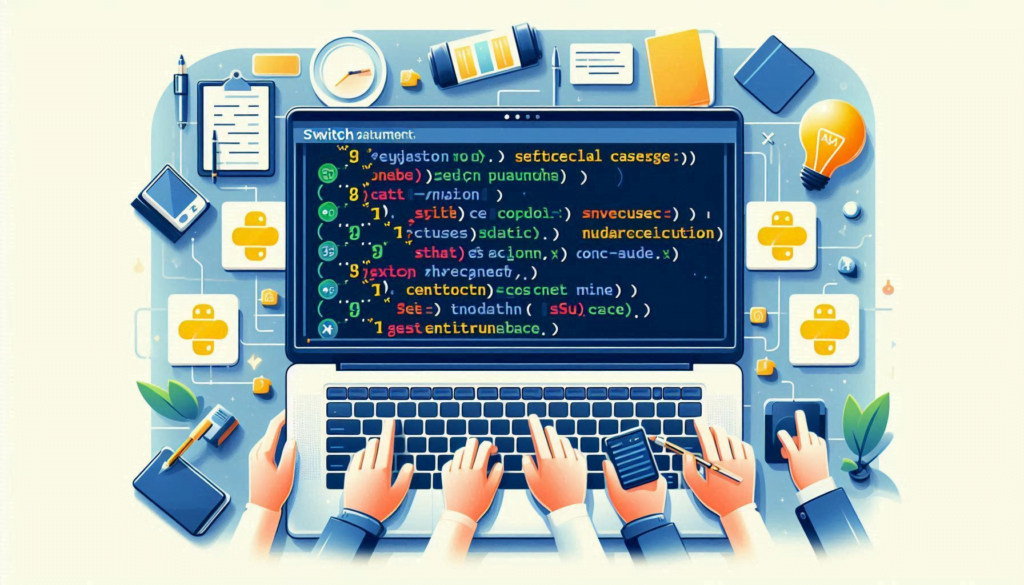In the ever-evolving realm of technology, programming languages are the unsung heroes behind the digital marvels we use every day. From the apps on your smartphone to the websites you browse, programming languages are the building blocks that bring these innovations to life. At Technology Moment, we dive deep into the fascinating world of programming languages, unraveling the intricacies and exploring the impact of each language on modern technology.
In this blog, we’ll embark on a journey through some of the most influential programming languages of our time. Whether you’re a seasoned developer, a curious beginner, or just someone interested in the tech world, our insights will help you understand the unique features, use cases, and best practices associated with languages like Python, Java, JavaScript, C++, Ruby, and Go. We’ll also provide practical tips and tutorials to guide you in harnessing the power of these languages.
Join us as we decode the language of technology and discover how these powerful tools shape our digital landscape. Welcome to Technology Moment—where the language of innovation comes to life!
Programming languages are at the core of every technological solution we interact with daily. From the apps on our smartphones to the websites we browse, programming languages make it all possible. But with the wide array of programming languages available, choosing the right one for your project can feel overwhelming. Each language comes with its own set of features, strengths, and best use cases, making it essential to understand what differentiates them.
In this section, we’ll provide an overview of what programming languages are and why they are important in the context of modern technology. We’ll also highlight the significance of selecting the right language for a particular project, as the choice you make can directly impact the efficiency, scalability, and success of your development efforts.
Whether you’re a beginner learning to code or an experienced developer trying to expand your skill set, understanding the variety of programming languages available and their unique use cases is key to making informed decisions. After all, programming is not just about writing code—it’s about finding the right tool for the right job.
By the end of this post, you’ll have a better grasp of popular programming languages like Python, Java, JavaScript, C++, Ruby, and Go. You’ll also learn how each of these languages can be applied to different areas of software development, which will help guide you in selecting the best one for your next project.
So, whether you’re looking to build a web app, create a mobile game, or dive into artificial intelligence, the following guide will offer valuable insights to get you started.
Table of Contents
What is a Programming Language?
A programming language is a formal set of instructions that allows humans to communicate with computers and create software applications. Think of it as the bridge between human logic and machine understanding. Just as humans use languages like English or Spanish to communicate with each other, programmers use programming languages to “talk” to computers.
Programming languages consist of a set of rules, syntax, and keywords that define how instructions are structured. These languages enable developers to write code that can control the behavior of a computer or any other machine that operates using software. Without programming languages, computers would be nothing more than complex, unresponsive pieces of hardware.
The Function of Programming Languages
Programming languages translate human-readable code into machine code, which computers can execute. A programmer writes instructions in a high-level language (like Python or Java), and these instructions are then converted into low-level machine code (binary) via a compiler or an interpreter.
Here’s how it works:
- High-Level Language: The programmer writes code in a language that’s easy for humans to understand (e.g., Python).
- Translation: The code is then translated into machine code through a compiler or interpreter.
- Execution: The computer reads the machine code and performs the desired actions, like running a program, calculating data, or controlling devices.
Types of Programming Languages
There are different types of programming languages, categorized based on their level of abstraction:
- Low-Level Languages (Assembly, Machine Code): These are closer to the computer’s hardware and are harder for humans to understand but run very efficiently. They provide control over hardware and memory.
- High-Level Languages (Python, Java, JavaScript): These are more abstract, designed to be human-readable, and allow developers to focus on logic and functionality without worrying about hardware specifics.
High-level languages are typically more user-friendly, but the lower-level ones provide more control and are often used for tasks requiring direct hardware manipulation.
The Role of Programming in Modern Technology
Programming languages power everything from the apps on your phone to the websites you browse and the complex systems that run industries like healthcare, finance, and entertainment. The importance of programming in modern technology cannot be overstated. With these languages, we build tools that solve problems, automate processes, and enhance efficiency in virtually every sector.
For instance:
- Web Development: Programming languages like JavaScript create dynamic websites.
- Mobile Apps: Languages like Java (for Android) and Swift (for iOS) are used to develop mobile apps.
- Artificial Intelligence and Machine Learning: Python is widely used for AI and data science because of its simplicity and vast library support.
In short, programming languages are the building blocks of the digital world, enabling us to create technology that improves and simplifies our lives.
Why Are There So Many Programming Languages?
The sheer number of programming languages can seem overwhelming to both beginners and experienced developers. However, there’s a good reason why so many programming languages exist — and it all boils down to different needs, technological advancements, and preferences.
1. The Evolution of Technology and Programming
The first programming languages were quite primitive and tailored to specific tasks. For example, early languages like FORTRAN (Formula Translation) were created for scientific and engineering calculations, while COBOL (Common Business-Oriented Language) was designed for business data processing.
As computing needs became more diverse, new programming languages were developed to address various challenges. Over the decades, advancements in computer hardware, software complexity, and user demands have led to the creation of languages that are more efficient, versatile, and easier to use. Each era of computing brought forth languages that suited the needs of that time.
2. Different Languages for Different Problems
No single programming language is perfect for every task. Different problems require different tools, and programming languages are no exception. Some languages excel in speed and efficiency, while others prioritize simplicity and readability. Here’s a breakdown of how some languages fit different needs:
- Performance-Driven Applications: Languages like C++ and Rust are commonly used for tasks that require high performance, such as game development and system-level software. They offer fine control over memory management, which is essential for performance-critical applications.
- Web Development: For building websites, languages like JavaScript, PHP, and Ruby are more common. JavaScript, for instance, dominates web development because it runs directly in browsers, allowing for dynamic and interactive web pages.
- Data Science and AI: In fields like data science and artificial intelligence, Python is incredibly popular. It has a large ecosystem of libraries and frameworks, making complex tasks easier to handle.
- Enterprise Software: For large-scale enterprise applications, Java is often the go-to language due to its portability (write once, run anywhere), robust libraries, and strong security features.
3. Developer Preferences and Productivity
Programming languages are also created with the aim of improving developer productivity and satisfaction. Some languages prioritize ease of use, making it simpler for developers to write and maintain code. For instance, Python is favored for its clean and readable syntax, which reduces the cognitive load on developers.
Meanwhile, languages like Ruby emphasize programmer happiness, providing elegant solutions and conventions that allow for rapid development without compromising quality. Developers gravitate toward languages that align with their preferences and allow them to work more efficiently.
4. Legacy Systems and Compatibility
Another reason for the existence of multiple programming languages is the need for backward compatibility and maintaining legacy systems. Many older systems were built using languages that were popular at the time, such as COBOL for banking and government systems. These systems are still in use today, which means that there’s a continued need for developers who can work with these older languages.
At the same time, newer languages are continuously being developed to integrate with, or replace, older ones while offering improved features and performance. For example, Go (Golang) was created to address performance and scalability issues in cloud-based systems, offering a modern alternative to older languages like C and C++.
5. Specialization and Niche Needs
Some languages are designed for niche markets or specialized tasks. For example, SQL (Structured Query Language) is a domain-specific language used specifically for managing databases. R is another specialized language designed for statistical computing and graphics.
These specialized languages exist because they offer features that general-purpose languages may lack. By tailoring a language to a specific domain, developers can create more efficient, effective solutions for that particular area.
6. Innovation and Experimentation
Lastly, many programming languages are born out of experimentation and innovation. Researchers and developers are constantly seeking ways to improve how we write software, leading to the creation of new languages that incorporate novel ideas. For example, languages like Scala and Kotlin were developed to improve upon limitations in existing languages like Java, providing more modern features such as functional programming paradigms and enhanced type safety.
Some languages also focus on specific goals such as concurrency, safety, or immutability, which can be vital in particular types of systems (e.g., cloud services or financial software). This diversity of ideas fosters innovation in the programming landscape.
Python: The All-Rounder
Features of Python
Python is often referred to as the “Swiss Army knife” of programming languages because of its simplicity, versatility, and power. It was created by Guido van Rossum in the late 1980s and has grown to become one of the most widely used languages today. Python is known for its:
- Readability: Python’s syntax is designed to be easy to read and write, making it an excellent choice for beginners and seasoned developers alike. The language emphasizes using natural language, which means you can often understand Python code at a glance.
- Flexibility: Python supports multiple programming paradigms such as procedural, object-oriented, and functional programming, which allows developers to choose the best approach for their specific task.
- Extensive Libraries and Frameworks: Python has a vast ecosystem of libraries and frameworks (like NumPy, Pandas, Django, Flask, TensorFlow, and more) that make it suitable for various tasks, ranging from web development to machine learning.
- Cross-Platform Compatibility: Python runs on various platforms (Windows, macOS, Linux), and code can be easily shared and run across different systems without modification.
Use Cases of Python
Python is often called an “all-rounder” because of its ability to handle a wide variety of tasks, making it useful in many fields, including:
- Web Development: Frameworks like Django and Flask make Python a top choice for building web applications. Django, in particular, is known for enabling rapid development while adhering to best practices.
- Data Science and Machine Learning: Python is a go-to language for data scientists due to libraries like Pandas for data manipulation, NumPy for numerical computations, and Matplotlib for visualization. Machine learning libraries like TensorFlow and Scikit-learn allow developers to create powerful AI models.
- Automation/Scripting: Python is commonly used for automating repetitive tasks, such as file manipulation, data scraping, or even controlling complex systems.
- Artificial Intelligence (AI) and Deep Learning: Python’s simplicity and extensive library support make it ideal for developing AI algorithms. TensorFlow and PyTorch are two leading frameworks that rely on Python for developing neural networks and deep learning models.
- Game Development: Python can also be used for simple game development using libraries like Pygame. While not as performance-oriented as C++ for high-end games, Python offers an easy starting point for game development enthusiasts.
- Scientific Computing: Python’s SciPy and NumPy libraries are widely used in scientific communities for research and simulations, making Python a popular choice for researchers and engineers.
Best Practices for Python Development
To get the most out of Python, developers should adhere to certain best practices:
- Write Clean and Readable Code: Use descriptive variable and function names, follow Python’s naming conventions (like snake_case for variables and functions), and keep the codebase organized for readability.
- Take Advantage of Libraries: Rather than reinventing the wheel, Python offers an extensive range of libraries for almost any task. Utilize them to save time and enhance efficiency.
- Use Virtual Environments: Python allows the creation of virtual environments to manage dependencies for different projects. This ensures that your project will run with the same package versions it was developed with, avoiding “dependency hell.”
- Follow the PEP 8 Style Guide: PEP 8 is the official style guide for Python, providing rules and conventions on how to format Python code for consistency across projects.
- Handle Errors Gracefully: Use try-except blocks to manage exceptions and ensure that your code can handle unexpected errors without crashing.
- Test Your Code: Unit testing ensures that your Python code works as expected. Frameworks like pytest and unittest make it easy to write tests and maintain code quality.
Why is Python So Popular?
Python’s popularity stems from its versatility and the strong community support it enjoys. Whether you’re a beginner learning your first programming language or a professional developing complex systems, Python’s simple syntax, combined with its powerful capabilities, makes it an ideal choice. The language’s open-source nature also means it’s continuously evolving, with contributions from developers worldwide who enhance its libraries, frameworks, and performance.
Python is a language that can grow with you. You can start with small scripts to automate tasks, then scale up to complex applications in web development, AI, or scientific computing as you gain more experience.
Java: The Versatile Workhorse
Java is often referred to as the “workhorse” of the programming world due to its robustness, versatility, and widespread use. Since its release in 1995 by Sun Microsystems (later acquired by Oracle), Java has become one of the most popular programming languages for developers across industries. Its “write once, run anywhere” philosophy allows Java programs to run on any device that supports the Java Virtual Machine (JVM), making it highly portable and adaptable.
Features of Java
- Platform Independence Java’s platform independence is one of its standout features. Thanks to the JVM, a Java program written on one platform can be executed on any other platform without needing modification. This cross-platform capability makes Java particularly useful for large, enterprise-level applications that need to run in diverse environments.
- Object-Oriented Java is a fully object-oriented programming (OOP) language, meaning it allows developers to structure programs around objects and data rather than functions and logic. This approach enables more modular, reusable, and flexible code, making Java ideal for complex, scalable applications.
- Robustness and Reliability Java places a strong emphasis on catching errors early during compilation, which reduces runtime issues. Features like exception handling, garbage collection, and strong memory management contribute to Java’s reliability and prevent many types of programming mistakes that could lead to crashes or security vulnerabilities.
- Security Security has always been a focus of Java. The language provides built-in features to develop secure applications, such as bytecode verification, sandboxing, and encryption libraries. These attributes are especially crucial for applications involving sensitive data, like financial or healthcare systems.
- Multithreading Java supports multithreading, allowing multiple operations to be executed simultaneously within the same program. This capability is essential for high-performance applications, especially in areas like video games, financial services, and scientific computing.
Use Cases of Java
- Enterprise Software Java is the go-to language for enterprise software development, powering large-scale systems like banking platforms, customer relationship management (CRM) systems, and enterprise resource planning (ERP) applications. Its stability, scalability, and security make it ideal for industries that require robust and efficient solutions.
- Android App Development Java is the primary language used for Android app development. The Android operating system relies heavily on Java, and most Android apps are written using Java and the Android SDK. Developers who want to create mobile applications for Android often prefer Java due to its established ecosystem and tools.
- Web Development Java is commonly used on the back end for web development. Frameworks like Spring and JavaServer Pages (JSP) are widely adopted for building secure and scalable web applications. These frameworks are favored by enterprises for building web applications that require high performance and strong security features.
- Big Data and Cloud Computing Java plays a significant role in big data technologies. Tools like Apache Hadoop and Apache Spark are written in Java, making it a natural choice for developers working with big data. In cloud computing, Java’s portability and multithreading features are valuable for building cloud-based solutions that need to scale easily.
Best Practices for Java Development
- Adopt OOP Principles Since Java is an object-oriented language, it’s crucial to follow OOP best practices such as encapsulation, inheritance, and polymorphism. These principles allow you to write more maintainable and scalable code.
- Use Design Patterns Java’s ecosystem is rich with established design patterns, such as Singleton, Factory, and Observer, which provide reusable solutions to common problems. Leveraging these patterns can make your code more efficient and reduce development time.
- Efficient Memory Management Although Java has an automatic garbage collection system, developers should still be cautious of memory usage. Avoid creating unnecessary objects and ensure proper memory management to maintain application performance, especially in large, long-running applications.
- Test-Driven Development (TDD) Java development benefits greatly from test-driven development, where tests are written before the code. This practice ensures that your application works as intended from the ground up and can be particularly useful in avoiding bugs in enterprise-level systems.
- Keep Code Modular and DRY (Don’t Repeat Yourself) Following the DRY principle by reusing code as much as possible reduces redundancy and makes your codebase cleaner and more maintainable. It’s also important to modularize your code, breaking it into smaller components that are easier to test and maintain.
Why Java Remains Popular
Java remains a top choice for developers because of its combination of reliability, flexibility, and scalability. It has an enormous ecosystem of libraries and frameworks, making it easier to build applications for virtually any industry. Java’s backward compatibility ensures that even older systems can be maintained and updated without requiring complete rewrites, which is a huge advantage for enterprise software.
Moreover, Java continues to evolve with regular updates and improvements. With each new release, the language becomes more efficient, secure, and versatile, keeping it competitive in the rapidly evolving tech landscape.
In short, Java is a true workhorse. Its ability to handle high-performance applications, run on any platform, and offer a range of powerful features makes it a top choice for developers building everything from mobile apps to enterprise software.
JavaScript: The Language of the Web
JavaScript has earned its place as one of the most essential programming languages, especially when it comes to web development. It’s the backbone of interactivity on websites, and it’s nearly impossible to think of modern web applications without it.

Features of JavaScript
- Dynamic and Versatile: JavaScript is a dynamically typed language, meaning that variables don’t have to be defined with a specific type. This flexibility allows developers to write code quickly and efficiently, making it ideal for fast prototyping.
- Client-Side and Server-Side Capabilities: Originally, JavaScript was strictly a client-side language, meaning it ran in the browser to handle things like animations, form validations, and interactive content. But with the introduction of frameworks like Node.js, JavaScript has expanded its role to server-side development, meaning you can use it to build entire web applications from front-end to back-end.
- Event-Driven Programming: JavaScript is built around the concept of event-driven programming, meaning actions (such as a user clicking a button) trigger functions that respond to those events. This makes it an ideal language for creating dynamic, interactive web pages where users interact directly with content.
- Object-Oriented and Functional Programming Support: JavaScript supports both object-oriented and functional programming paradigms, offering flexibility to developers. You can use it to write clean, maintainable code with reusable components.
- Rich Ecosystem: JavaScript has a massive ecosystem, filled with libraries (like jQuery) and frameworks (like React, Angular, and Vue.js) that make developing complex applications easier. These tools streamline common tasks, such as DOM manipulation, state management, and creating user interfaces.
Use Cases of JavaScript
- Front-End Web Development: JavaScript is primarily known for its role in front-end development. It’s what allows websites to be more than just static pages. With JavaScript, you can create interactive elements such as forms, sliders, navigation menus, and more. JavaScript frameworks like React, Vue.js, and Angular make front-end development easier by providing reusable components and efficient ways to manage the user interface.
- Server-Side Development with Node.js: While JavaScript was initially a browser language, the introduction of Node.js brought it into the world of server-side development. With Node.js, JavaScript can handle server-side logic, manage databases, and serve content to users, making it possible to build full-stack applications entirely with JavaScript.
- Mobile App Development: Through frameworks like React Native, JavaScript allows developers to create mobile applications that run on both iOS and Android. This cross-platform capability saves time and resources, as you don’t need separate codebases for each platform.
- Web Applications: Web applications like Gmail, Facebook, and Twitter use JavaScript to provide users with smooth, fast, and interactive experiences. Single Page Applications (SPAs), which load only once and dynamically update content as needed, are heavily reliant on JavaScript for this functionality.
- Game Development: While not as common as languages like C++ in high-performance game development, JavaScript is still used for browser-based games. Libraries like Phaser.js and Babylon.js make it easier to create 2D and 3D games that can run directly in a web browser.
- Machine Learning: With the rise of libraries like TensorFlow.js, JavaScript is now being used in machine learning. Developers can run machine learning models directly in the browser, allowing for real-time processing and user interaction without needing to rely on back-end servers.
Best Practices for JavaScript Development
- Follow Consistent Coding Conventions: JavaScript is flexible, but with that flexibility comes the risk of messy, hard-to-read code. Adopting consistent naming conventions, indentation, and commenting practices will make your JavaScript code cleaner and more maintainable.
- Use Frameworks and Libraries Wisely: While JavaScript offers a wealth of frameworks and libraries, over-reliance on them can lead to bloated applications. It’s best to choose the right tool for the job and avoid unnecessary dependencies.
- Optimize for Performance: JavaScript is a client-side language, meaning it runs directly in the user’s browser. Inefficient code can lead to slow load times and poor user experience. To avoid this, focus on performance optimization techniques like minimizing DOM manipulations, debouncing/throttling event listeners, and using asynchronous operations where possible.
- Use Modern JavaScript (ES6 and Beyond): JavaScript has evolved, and modern versions (starting with ECMAScript 6, or ES6) introduced a lot of powerful features like arrow functions, destructuring, and template literals. Utilizing these modern features not only makes your code more efficient but also easier to understand.
- Write Unit Tests: Testing is an essential part of any development process, and JavaScript is no different. Writing unit tests with tools like Jest or Mocha ensures that your code works as expected and helps prevent bugs from cropping up as your codebase grows.
Why JavaScript Dominates Web Development
JavaScript’s dominance in web development comes from its adaptability and the sheer number of tools available for developers. Whether you’re building a small portfolio website or a complex, interactive web application, JavaScript can do it all. Its ability to run both in the browser and on the server gives developers an edge in building fast, seamless applications that users love. Additionally, JavaScript’s thriving community continually pushes the boundaries, developing new libraries and frameworks that make development easier and faster.
C++: The High-Performance Powerhouse
Features of C++
C++ is renowned for its performance and versatility. Developed by Bjarne Stroustrup in the early 1980s as an extension of the C programming language, C++ incorporates both high-level and low-level programming features.
- Object-Oriented Programming (OOP): C++ supports OOP principles such as inheritance, encapsulation, and polymorphism. This allows developers to create modular and reusable code, which enhances code maintainability and scalability.
- Low-Level Manipulation: C++ provides the ability to perform low-level memory manipulation, which can lead to more optimized and efficient code. This is particularly useful in systems programming where direct hardware access is often required.
- Performance: C++ is known for its high performance due to its close-to-the-metal nature. It allows for fine-grained control over system resources, making it ideal for applications where speed and resource efficiency are critical.
- Standard Template Library (STL): The STL provides a rich set of template-based classes and functions. It includes commonly used data structures such as vectors, lists, and queues, along with algorithms for sorting and searching.
- Multi-Paradigm Support: In addition to OOP, C++ supports procedural and generic programming. This flexibility enables developers to choose the best paradigm for their specific application needs.
Use Cases
C++ is used in a wide range of applications where performance and efficiency are crucial:
- Game Development: Many game engines, including Unreal Engine, are written in C++ due to its performance capabilities. Games often require real-time processing and high-speed computations, which C++ handles exceptionally well.
- System Software: Operating systems, drivers, and other system-level software benefit from C++’s ability to interact closely with hardware and manage system resources efficiently.
- Embedded Systems: C++ is commonly used in embedded systems and IoT devices because of its low-level manipulation capabilities and performance.
- High-Performance Applications: Applications that require complex calculations, such as financial trading systems and scientific simulations, often leverage C++ for its speed and efficiency.
Best Practices for C++ Development
To make the most of C++’s features and avoid common pitfalls, follow these best practices:
- Memory Management: While C++ offers manual memory management, it’s essential to handle it carefully to avoid issues like memory leaks and dangling pointers. Using smart pointers (
std::unique_ptr,std::shared_ptr) can help manage resources more safely. - Code Organization: Use proper code organization techniques, such as separating interface and implementation (header and source files), to keep your code clean and manageable.
- Avoid Global Variables: Minimize the use of global variables to reduce potential conflicts and maintain modular code. Instead, use classes and encapsulate data within objects.
- Use RAII (Resource Acquisition Is Initialization): RAII is a C++ programming idiom where resources are acquired and released within object constructors and destructors. This helps manage resources automatically and safely.
- Optimize with Care: While C++ allows for low-level optimizations, it’s important to profile and test your code to ensure that optimizations are necessary and effective. Premature optimization can lead to complex and less maintainable code.
Ruby: The Developer’s Best Friend
Developed in the mid-1990s by Yukihiro Matsumoto, Ruby was designed to make programming more enjoyable and efficient. It combines elements of various programming paradigms, making it a versatile tool for developers.
Features of Ruby
- Readable and Elegant Syntax: The language emphasizes simplicity and ease of use, which makes it particularly attractive to beginners. Its syntax is designed to be intuitive, allowing developers to write code that is not only functional but also easy to understand. For example, Ruby uses straightforward and natural syntax for defining methods and handling errors, which reduces the cognitive load on developers.
- Object-Oriented Nature: Everything in Ruby is an object, including primitive data types. This pure object-oriented approach means that developers can apply object-oriented principles consistently throughout their code. This leads to a more organized and modular codebase, where concepts like inheritance, encapsulation, and polymorphism can be used effectively.
- Dynamic Typing: Ruby uses dynamic typing, which means that you don’t need to specify the data types of variables explicitly. This flexibility can speed up development and reduce the amount of boilerplate code. However, it also requires developers to be cautious about type-related errors that might only surface at runtime.
- Garbage Collection: Ruby includes built-in garbage collection, which automatically manages memory allocation and deallocation. This feature helps prevent memory leaks and simplifies memory management, allowing developers to focus more on writing business logic rather than managing memory.
- Metaprogramming: Ruby supports metaprogramming, which allows developers to write code that manipulates other code. This powerful feature enables dynamic creation of methods and classes, and can lead to more flexible and reusable code. However, it should be used judiciously to avoid making the codebase overly complex.
Use Cases for Ruby
- Web Development: Ruby is most famous for its use in web development, primarily through the Ruby on Rails framework. Rails, often just called “Rails,” is a robust and opinionated framework that provides a convention-over-configuration approach. It emphasizes best practices, such as the MVC (Model-View-Controller) pattern, which helps developers build web applications quickly and efficiently. Rails includes many built-in features, such as database migrations and scaffolding, which streamline the development process.
- Prototyping: Due to its simplicity and rapid development capabilities, Ruby is an excellent choice for prototyping. Developers can quickly create and iterate on ideas, making Ruby a popular choice for startups and projects in their early stages. The language’s concise syntax and rich set of libraries accelerate the development of proofs of concept and MVPs (Minimum Viable Products).
- Automation and Scripting: Ruby’s ease of use and readable syntax also make it suitable for writing scripts and automating repetitive tasks. Whether it’s data processing, file manipulation, or system administration, Ruby’s versatility allows developers to automate various workflows efficiently.
Best Practices for Ruby Development
- Follow the Rails Convention: If you’re using Ruby on Rails, adhering to its conventions is crucial. Rails provides a set of conventions and best practices that streamline development and improve maintainability. By following these conventions, you can leverage the full power of Rails and avoid common pitfalls.
- Write Tests: Ruby and Rails come with built-in testing frameworks, such as RSpec and Minitest. Writing tests helps ensure that your code behaves as expected and allows you to catch bugs early in the development process. Test-driven development (TDD) is a common practice in the Ruby community, promoting high-quality, reliable code.
- Use Gems Wisely: RubyGems is the package manager for Ruby, offering a vast repository of libraries and tools. While gems can greatly enhance your development process, it’s important to evaluate their quality and compatibility. Avoid overusing gems and prefer well-maintained ones to prevent potential issues.
- Optimize Performance: Although Ruby is known for its developer-friendly features, it may not always match the performance of lower-level languages like C++. Consider techniques such as caching and query optimization to improve performance.
- Keep Code Clean and DRY: Ruby emphasizes the DRY (Don’t Repeat Yourself) principle, which encourages reducing redundancy and keeping code clean and maintainable. Use Ruby’s powerful abstractions to avoid repetitive code and maintain a clean, readable codebase.
Go (Golang): The Efficiency Expert
Its primary focus is on efficiency and simplicity, making it a popular choice for developing high-performance applications. Here’s an in-depth look at why Go stands out and how it can be beneficial for your projects.
Features of Go
- Simplicity and Readability: Go is known for its simplicity and minimalism. Its syntax is clean and easy to understand, which makes it accessible to both beginners and experienced developers. The language avoids unnecessary complexity, focusing instead on providing a straightforward approach to programming.
- Concurrency: Through goroutines and channels, Go simplifies the development of applications that perform multiple tasks simultaneously. Goroutines are lightweight threads managed by the Go runtime, and channels provide a way for these goroutines to communicate with each other. This feature is particularly useful for applications requiring high performance and scalability.
- Fast Compilation: Go is designed to compile quickly, which significantly speeds up the development process. This fast compilation time enhances productivity, allowing developers to iterate on their code more efficiently and deploy changes faster.
- Garbage Collection: This reduces the need for manual memory management, making the development process smoother and less error-prone.
- Standard Library: Go comes with a robust standard library that includes packages for common tasks such as input/output operations, string manipulation, and networking. This extensive library reduces the need for third-party dependencies and accelerates development.
- Cross-Platform Support: Go is cross-platform, meaning it can be used to build applications for various operating systems, including Windows, macOS, and Linux. This versatility allows developers to write code once and deploy it across different platforms with minimal adjustments.
Use Cases for Go
- Cloud Services and Microservices: Go’s concurrency model and performance make it an excellent choice for developing cloud services and microservices. Many companies use Go to build scalable, distributed systems that handle large volumes of traffic and data.
- Web Servers and APIs: Go is frequently used for creating web servers and APIs due to its efficiency and speed. The language’s simplicity allows for rapid development and deployment of high-performance web applications.
- DevOps and Tools: Go is popular in the DevOps community for developing tools and utilities. Its fast compilation, ease of deployment, and efficient performance make it ideal for building command-line tools, automation scripts, and other DevOps-related applications.
- Networking and Distributed Systems: The language’s built-in support for concurrent programming and network libraries makes it a great fit for developing networking applications and distributed systems. Go’s performance is well-suited for handling complex network operations and large-scale data processing.
Best Practices for Go Development
- Embrace Go’s Idioms: Go has its own set of idioms and best practices. Familiarize yourself with Go’s conventions, such as using short variable names and avoiding unnecessary complexity in your code. Following these idioms will help you write idiomatic Go code that is easy to read and maintain.
- Use Goroutines Wisely: While goroutines are powerful, using them efficiently requires careful consideration. Avoid spawning too many goroutines, as this can lead to performance issues. Instead, use them judiciously and manage their lifecycle properly.
- Leverage the Standard Library: Go’s standard library is extensive and well-documented. Take advantage of the built-in packages for common tasks rather than relying on third-party libraries. This practice reduces the risk of introducing bugs and improves the stability of your applications.
- Write Tests: Go includes a built-in testing framework that makes it easy to write and run tests. Make sure to write unit tests for your code to ensure its correctness and reliability. Testing is crucial for catching issues early and maintaining code quality.
- Keep It Simple: One of Go’s core principles is simplicity. Aim to keep your code straightforward and avoid adding unnecessary complexity.
Comparing These Programming Languages
When it comes to choosing a programming language for your project, it’s essential to understand the strengths and weaknesses of each language. Here’s a detailed comparison of Python, Java, JavaScript, C++, Ruby, and Go, focusing on ease of learning, performance, and versatility.
Ease of Learning
Python: Its syntax closely mirrors natural language, making it an excellent choice for beginners. Python’s extensive standard library and supportive community also make learning easier. It’s often the first language taught in programming courses due to its clear and concise syntax.
Java: Java is more complex than Python due to its verbose syntax and strict object-oriented principles. However, it has a strong, well-documented framework that helps learners understand programming concepts. Java’s widespread use in academia and industry also means that there are many resources available for learners.
JavaScript: JavaScript is relatively easy to start with, especially for those interested in web development. Its syntax is straightforward, and it integrates directly into web browsers, allowing immediate feedback. However, JavaScript’s asynchronous nature and quirks can pose challenges for beginners.
C++: C++ is known for its complexity. It offers extensive control over system resources and memory management, but this can make it more challenging to learn. C++’s syntax and features require a deeper understanding of programming concepts, making it less beginner-friendly compared to Python or Java.
Ruby: Ruby is designed to be simple and intuitive, with a focus on making programming enjoyable. Its syntax is elegant and flexible, which can make it easier for beginners to pick up. Ruby’s convention-over-configuration philosophy simplifies many tasks, making it a good choice for those new to programming.
Go (Golang): Go is designed with simplicity in mind, similar to Python. Its syntax is clean and concise, and it avoids many of the complexities of other languages. Go’s simplicity and efficient concurrency model make it approachable for new programmers, although it may lack some advanced features found in other languages.
Performance and Speed
Python: Python is an interpreted language, which means it’s generally slower than compiled languages like C++ and Java. Its performance can be improved using tools like PyPy or by integrating with C/C++ code for performance-critical sections. However, Python’s ease of use often outweighs its slower execution speed.
Java: This setup allows for relatively fast execution and cross-platform compatibility. Java’s performance is typically better than Python but might not match the raw speed of C++.
JavaScript: JavaScript’s performance can vary depending on the environment. In the browser, JavaScript engines like V8 (used by Chrome) optimize code execution, making it fast. On the server side with Node.js, JavaScript can handle high concurrency efficiently, although it may still lag behind compiled languages in raw performance.
C++: C++ is known for its high performance and efficiency. It’s a compiled language that gives programmers direct control over system resources and memory, making it ideal for applications requiring intensive computation, such as game development and system software.
Ruby: Ruby’s performance is often considered slower compared to languages like Java and C++. While it is sufficient for many web applications, Ruby’s performance can become a bottleneck in high-traffic scenarios. Optimization tools and techniques are available but often require additional effort.
Go (Golang): Go offers a good balance of performance and simplicity. Its compiled nature ensures fast execution, and its efficient garbage collector and concurrency model contribute to high performance.
Flexibility and Versatility
Python: Python is highly versatile and used in a wide range of domains, including web development, data analysis, artificial intelligence, scientific computing, and automation. Its extensive libraries and frameworks, like Django and TensorFlow, enhance its flexibility.
Java: Java’s versatility is seen in its use across various platforms, from Android apps to large-scale enterprise systems. Its robust ecosystem includes frameworks like Spring and Hibernate, which add to its flexibility for different types of applications.
JavaScript: JavaScript’s primary role is in web development, both on the client side and server side (with Node.js). It’s essential for creating interactive web applications and is increasingly used in mobile app development through frameworks like React Native.
C++: C++ is known for its performance and control, making it suitable for systems programming, game development, and applications where direct hardware interaction is required. While not as versatile as some other languages, its strengths lie in high-performance and resource-intensive applications.
Ruby: Ruby is primarily associated with web development, especially with the Ruby on Rails framework. Its focus on developer happiness and productivity makes it less versatile than some other languages but highly effective for rapid web application development.
Go (Golang): Go is designed for concurrency and scalability, making it an excellent choice for cloud services, distributed systems, and large-scale applications. Its simplicity and performance make it a strong candidate for modern backend development and system programming.
How to Pick the Appropriate Programming Language for Your Task
Selecting the right programming language for your project is crucial. The language you choose can significantly impact the development process, the quality of the final product, and even the long-term maintainability of your project.

1. Assess Your Project Requirements
Start by understanding the specific needs of your project. Different programming languages excel in different areas, so it’s important to align your choice with the project’s requirements.
- Type of Application: What kind of application are you building? For example, Python is often used for data science and machine learning, while JavaScript is essential for web development.
- Performance Needs: Does your project require high performance and speed? For applications that demand intensive computations, C++ might be a better fit due to its efficiency and performance.
- Scalability: Java and Go are known for their ability to handle large-scale applications with high performance.
2. Evaluate Language Features
Each programming language has unique features that can make it more suitable for specific types of projects.
- Syntax and Readability: Some languages, like Python, are known for their clean and readable syntax, which can be advantageous for rapid development and ease of maintenance.
- Libraries and Frameworks: Check if the language has a robust ecosystem of libraries and frameworks that can speed up development. For instance, Ruby on Rails is a powerful framework for building web applications in Ruby.
- Concurrency and Multithreading: If your project involves concurrent tasks or multi-threading, languages like Go, with its built-in concurrency model, might be more appropriate.
3. Consider Development Speed and Ease of Use
The ease with which you can develop and maintain your project is another key factor.
- Learning Curve: Choose a language that you or your team is comfortable with. Languages with simpler syntax, like Python, can speed up the learning process and development time.
- Tooling and IDE Support: A language with strong Integrated Development Environment (IDE) support and tooling can enhance productivity. Java, for example, benefits from robust IDEs like IntelliJ IDEA and Eclipse.
4. Evaluate Community Support and Resources
The strength of a language’s community can significantly affect your project’s development process.
- Community Size: A large, active community can provide a wealth of resources, including libraries, frameworks, and support. Languages like JavaScript and Python have extensive communities and abundant resources.
- Documentation and Tutorials: Good documentation and learning materials can be extremely helpful. Look for languages with comprehensive and well-maintained documentation.
5. Assess Long-Term Maintenance and Support
Think about how easy it will be to maintain and update your project over time.
- Language Stability: Consider the stability and maturity of the language. Older, well-established languages like Java have a track record of stability.
- Future Prospects: Ensure the language is actively maintained and has a future. Emerging languages like Go have shown strong growth and support from major tech companies.
6. Evaluate Integration Needs
Determine how well the language integrates with other systems and technologies.
- Compatibility with Existing Systems: If your project needs to interact with existing systems, choose a language that is compatible and can integrate easily with those systems.
- APIs and External Services: Consider whether the language has good support for APIs and external services that you might need to use.
7. Cost and Resource Availability
Finally, consider the cost implications and resource availability.
- Development Costs: Evaluate the costs associated with using the language. Some languages may have higher costs due to the need for specialized knowledge or tools.
- Availability of Developers: Ensure there are enough skilled developers available for the language you choose. Popular languages like JavaScript and Python generally have a larger pool of developers.
Learning Multiple Languages: Is It Worth It?
In the rapidly evolving world of programming, the question of whether to learn multiple programming languages is often debated. The answer is generally “Yes,” but the reasons behind this are multifaceted. Let’s delve into why learning multiple programming languages can be incredibly beneficial.
The Benefits of Being a Polyglot Programmer
- Broader Skill Set: Learning multiple programming languages broadens your skill set, making you more versatile as a developer. Each language has its own strengths, weaknesses, and unique features. By understanding various languages, you can choose the most suitable one for a given task. For example, while Python is excellent for data analysis and scripting, JavaScript shines in web development.
- Enhanced Problem-Solving Skills: Exposure to different programming paradigms and languages enhances your problem-solving skills. Each language approaches problems differently. For instance, functional programming in Haskell differs greatly from object-oriented programming in Java. By mastering different paradigms, you become better at thinking creatively and solving complex problems.
- Increased Job Opportunities: Knowing multiple languages can make you a more attractive candidate to employers. Many companies use a variety of technologies, and being able to work with several programming languages means you can handle diverse projects and adapt to different tech stacks. This adaptability is particularly valuable in startups and companies undergoing technological transformation.
- Improved Understanding of Programming Concepts: Learning different languages provides a deeper understanding of fundamental programming concepts. Concepts like memory management, concurrency, and data structures are handled differently in various languages. Gaining experience in multiple languages helps solidify these concepts and understand how they apply across different contexts.
- Enhanced Career Flexibility: Career paths in technology are diverse. By learning multiple languages, you open up various career opportunities, from web development to system programming, data science, and beyond. This flexibility can be particularly advantageous if you decide to shift focus or explore new areas within the tech industry.
How Learning Multiple Languages Enhances Problem-Solving Skills
- Diverse Perspectives: Each programming language has its own idioms and best practices. Learning these different approaches can help you see problems from various perspectives. For instance, Python’s simplicity might lead you to prefer its concise syntax for rapid development, while Java’s strict typing system might encourage you to write more robust and error-free code.
- Algorithm and Data Structure Knowledge: Understanding how different languages handle algorithms and data structures can improve your overall coding skills. For example, learning how C++ manages low-level memory can make you more proficient in optimizing performance, while exploring Ruby’s elegant syntax might inspire cleaner, more readable code.
- Adaptability and Flexibility: Being proficient in multiple languages means you can adapt to different programming environments and requirements. This adaptability is crucial in dynamic projects where technology stacks might change or evolve. It allows you to quickly switch between languages as needed, making you a more effective and agile developer.
Practical Tips for Learning Multiple Languages
- Start with Core Languages: Begin with a few core languages that are widely used and have broad applications. For instance, Python, JavaScript, and Java are great starting points as they are prevalent in many fields. Mastering these will give you a solid foundation before branching out into more specialized languages.
- Projects with Practice: Building projects in different languages helps solidify your understanding and gives you practical experience. Try creating similar projects in different languages to understand how each handles various tasks.
- Join Communities and Forums: Engage with programming communities and forums for different languages. These platforms provide support, resources, and networking opportunities, which can be invaluable as you learn and grow in your programming journey.
- Stay Updated: Technology is constantly evolving. Stay updated with the latest developments in the languages you learn. Follow relevant blogs, participate in webinars, and contribute to open-source projects to keep your skills sharp and current.
Common Pitfalls When Learning Programming Languages
Learning to program can be a rewarding yet challenging journey. Many new programmers encounter common pitfalls that can hinder their progress. Understanding these challenges can help you navigate the learning process more effectively.
1. Overwhelming Amount of Information
Pitfall: One of the biggest challenges for beginners is the sheer volume of information they encounter. Programming languages come with a plethora of concepts, syntax rules, and best practices, which can be overwhelming.
Solution: Break down the learning process into manageable chunks. Focus on one concept at a time and use online resources like tutorials, videos, and coding exercises. Tools like interactive coding platforms can also help reinforce learning through practice.
2. Not Understanding the Basics Thoroughly
Pitfall: Many learners rush through basic concepts in their eagerness to start writing complex programs. Skipping foundational knowledge can lead to gaps in understanding that become problematic later.
Solution: Ensure you have a strong grasp of the fundamentals before moving on to advanced topics. Practice basic programming constructs like variables, loops, and functions thoroughly. Revisit basic concepts as needed and don’t hesitate to ask for help or seek clarification.
3. Lack of Practical Application
Pitfall: Theory alone isn’t enough to become proficient in programming. Many learners focus too much on understanding theoretical concepts without applying them in practical scenarios.
Solution: Apply what you learn by working on real projects. Building projects helps solidify your understanding and demonstrates how concepts work in practice.
4. Not Debugging Effectively
Pitfall: Beginners often struggle with debugging, which is the process of finding and fixing errors in code. Without effective debugging skills, identifying and resolving issues can be frustrating.
Solution: Learn and practice debugging techniques early on. Developing a systematic approach to debugging—such as isolating parts of your code and checking for errors—can greatly improve your problem-solving skills.
5. Fear of Failure and Making Mistakes
Pitfall: Many new programmers fear making mistakes, which can lead to hesitation and slower learning. This fear often stems from a lack of confidence or previous negative experiences.
Solution: Every programmer makes errors, and each mistake is an opportunity to learn and improve. Adopt a growth mindset and view challenges as opportunities to enhance your skills.
6. Not Practicing Regularly
Pitfall: Programming is a skill that requires regular practice. Inconsistent practice can lead to forgetting concepts and losing momentum.
Solution: Set aside dedicated time for coding practice. Consistent, focused practice helps reinforce learning and build your programming skills over time.
7. Ignoring Best Practices
Pitfall: Beginners may overlook best practices such as writing clean, readable code and following coding standards. This can lead to code that is hard to maintain or understand.
Solution: Learn and adhere to best practices for coding. Follow coding conventions, write meaningful comments, and keep your code organized. Adopting good habits early on will make your code more maintainable and easier to work with.
8. Relying Too Much on Copying Code
Pitfall: Copying code from online sources without understanding it can hinder learning. While it might solve an immediate problem, it doesn’t help in truly understanding how the code works.
Solution: Instead of just copying code, take the time to understand how it functions. Try to modify and adapt the code to see how changes affect the outcome. This deeper engagement will enhance your understanding and problem-solving abilities.
9. Not Seeking Help When Needed
Pitfall: Some learners struggle with problems in isolation, avoiding seeking help due to embarrassment or fear of appearing unknowledgeable.
Solution: Don’t hesitate to seek help when you’re stuck. Use online forums, communities, and mentors to get guidance. Engaging with others can provide new perspectives and accelerate your learning process.
10. Comparing Yourself to Others
Pitfall: It’s easy to compare your progress with others, especially with the abundance of shared accomplishments in online communities. This comparison can lead to discouragement.
Solution: Focus on your own learning journey. Everyone progresses at their own pace, and comparing yourself to others can be counterproductive. Set personal goals and celebrate your milestones, no matter how small.
The Future of Programming Languages
The landscape of programming languages is ever-evolving, driven by technological advancements, changing industry needs, and new programming paradigms. Understanding the future of programming languages can help you stay ahead in your career and make informed decisions about learning and adopting new technologies. Here’s a detailed look at what lies ahead for programming languages:
Emerging Languages to Watch
- Rust
- Overview: Rust is gaining popularity for its focus on memory safety and performance. Developed by Mozilla, it aims to provide the speed of C++ with a strong emphasis on preventing common programming errors, such as null pointer dereferences and buffer overflows.
- Why It Matters: Rust is increasingly used in systems programming and applications where performance and reliability are critical. Its growing adoption in the industry, including major tech companies like Microsoft and Google, suggests a promising future.
- Kotlin
- Overview: Kotlin, developed by JetBrains, is designed to be fully interoperable with Java while addressing some of Java’s limitations. It’s officially supported for Android development and is gaining traction in backend development.
- Why It Matters: Kotlin’s modern features, such as null safety and concise syntax, make it an attractive alternative to Java. Its continued integration into the Android ecosystem and its growing use in server-side applications highlight its future potential.
- Swift
- Overview: Swift, developed by Apple, is designed for iOS and macOS development. It aims to replace Objective-C with a more modern, user-friendly language that improves safety and performance.
- Why It Matters: Swift’s rapid evolution and growing adoption for Apple’s platforms indicate that it will play a significant role in the future of mobile app development. Its focus on performance and safety aligns with the increasing demand for high-quality mobile applications.
Trends in Programming Language Development
- Increased Focus on Performance and Safety
- Explanation: As applications become more complex and performance-critical, programming languages are increasingly focusing on safety and efficiency. Languages like Rust and Swift are examples of this trend, offering features that prevent common programming errors and enhance performance.
- Rise of Multi-Paradigm Languages
- Explanation: The future of programming languages will likely see a rise in multi-paradigm languages that support various programming styles (e.g., procedural, object-oriented, functional). This flexibility allows developers to choose the best approach for a given problem, improving productivity and code quality.
- Integration with Machine Learning and Data Science
- Explanation: As machine learning and data science continue to grow, programming languages are evolving to better support these fields. Languages like Python have already made significant strides in this area, and future languages may include more built-in support for data science and AI applications.
- Increased Emphasis on Web and Cloud Development
- Explanation: With the growth of web and cloud computing, programming languages are increasingly focusing on these areas. Languages like JavaScript and Go are becoming central to web development and cloud-based applications, reflecting the ongoing shift towards web and cloud services.
- Enhanced Tooling and Developer Experience
- Explanation: Future programming languages will likely continue to improve developer productivity through better tooling, such as integrated development environments (IDEs), debugging tools, and package managers. Enhancements in tooling can significantly impact the efficiency and ease of programming.
The Role of Community and Industry Adoption
- Community-Driven Innovation
- Explanation: The programming language community plays a crucial role in shaping the future of languages. Open-source contributions, community feedback, and collaboration drive innovation and help languages evolve to meet new challenges.
- Industry Adoption and Support
- Explanation: The adoption of programming languages by major tech companies and industry leaders can influence their future. Languages that receive strong industry support are more likely to grow and become widely used, impacting the overall programming landscape.
Conclusion
As we’ve explored throughout this blog, the world of programming languages is diverse and dynamic. Each language has its unique strengths, purposes, and best use cases, making it crucial to choose the right one for your specific needs and projects.

Recap of Key Points
- Versatility of Python: Python’s simplicity and readability make it a go-to choice for a wide range of applications, from web development and data science to artificial intelligence. Its extensive libraries and supportive community add to its versatility, making it ideal for both beginners and seasoned developers.
- Power of Java: Known for its portability and robustness, Java is a staple in enterprise environments and Android app development. Its strong object-oriented principles and vast ecosystem of tools and libraries ensure that it remains a relevant and reliable choice.
- JavaScript’s Dominance in Web Development: JavaScript is essential for creating interactive and dynamic web pages. With the rise of Node.js, JavaScript has also become a powerful tool for server-side development, broadening its application beyond just front-end development.
- Performance of C++: For applications where performance and efficiency are critical, such as game development and system-level programming, C++ offers unmatched control over system resources and execution speed. Its complex syntax and features require a deeper understanding but reward developers with high-performance applications.
- Simplicity and Productivity of Ruby: Ruby, particularly with the Ruby on Rails framework, is renowned for its ease of use and developer productivity. Its elegant syntax and convention-over-configuration philosophy streamline the development process, making it a preferred choice for web applications.
- Efficiency of Go (Golang): Go is designed for high performance and scalability, making it an excellent choice for modern cloud services and concurrent systems. Its straightforward syntax and efficient execution model help developers build robust and efficient applications.
Encouragement to Start Learning
Choosing a programming language is just the beginning of your coding journey. Each language you learn adds a new dimension to your skill set and opens up a variety of opportunities in different fields of technology. Whether you’re just starting out or looking to expand your expertise, diving into these languages can significantly enhance your problem-solving abilities and technical knowledge.
Remember, there’s no one-size-fits-all answer to which programming language is the best. The right choice depends on your specific goals, the projects you want to undertake, and the industries you’re interested in. Don’t be afraid to experiment with different languages and explore their unique features and applications.
Learning and mastering multiple programming languages can make you a more versatile and valuable developer. It can also provide you with a broader perspective on programming concepts and paradigms, improving your overall problem-solving skills and adaptability.
In conclusion, the world of programming languages is rich and full of possibilities. Embrace the journey, continue learning, and leverage the strengths of different languages to create innovative and impactful solutions. Your path as a programmer is as unique as the languages you choose to master.
FAQs – Frequently Asked Questions
What is the easiest programming language to learn?
The “easiest” programming language to learn can vary depending on individual background and learning style. However, Python is often considered one of the easiest languages for beginners. Here’s why:
- Simple Syntax: Python’s syntax is clear and straightforward, resembling natural language. This makes it easier to understand and write code compared to languages with more complex syntax.
- Extensive Documentation: Python has a wealth of tutorials, guides, and community support, which helps beginners learn quickly.
- Versatility: Python can be used for a wide range of applications, from web development to data analysis, allowing learners to explore various fields with one language.
Is it possible for me to study multiple programming languages at once?
Yes, you can learn multiple programming languages simultaneously, but it’s important to approach this strategically:
- Start with One Language: It’s usually best to begin with one language to build a solid foundation. This helps you understand fundamental programming concepts that are transferable to other languages.
- Choose Complementary Languages: If you decide to learn multiple languages at once, choose ones that complement each other. For example, learning Python and JavaScript together is a good choice because Python can be used for backend development while JavaScript is essential for frontend development.
- Set Clear Goals: This focus will help you manage your learning effectively and prevent overwhelm.
Which programming language is best for web development?
The best programming language for web development depends on whether you are focusing on frontend or backend development:
- Frontend Development: For building the visual and interactive aspects of a website, JavaScript is the most essential language. It works alongside HTML and CSS to create dynamic and responsive web pages. Frameworks and libraries like React.js and Angular.js further enhance JavaScript’s capabilities.
- Backend Development: For server-side programming, languages like Python, Ruby, and Java are popular choices. Python, with frameworks like Django and Flask, is known for its readability and efficiency. Ruby, particularly with Ruby on Rails, emphasizes convention over configuration, making development faster. Java, with its robust ecosystem, is widely used in large-scale enterprise applications.
How do I choose a language for a specific project?
Choosing the right programming language for a project involves evaluating several factors:
- Project Requirements: Identify the specific needs of your project. For example, if you’re developing a real-time web application, JavaScript and Node.js might be suitable.
- Performance Needs: Consider the performance requirements. For high-performance applications, like gaming or system-level software, languages like C++ might be more appropriate due to their efficiency and control over hardware.
- Team Expertise: Assess the skills and preferences of your team. Leveraging a language that your team is already familiar with can speed up development and reduce errors.
- Community and Ecosystem: Look at the libraries, frameworks, and community support available for each language. A strong ecosystem can make development faster and easier.
What are the key differences between Python and JavaScript?
Python and JavaScript are both versatile languages, but they have distinct differences:
- Primary Use: Python is often used for server-side applications, data analysis, machine learning, and automation. JavaScript, on the other hand, is primarily used for client-side web development, enabling interactive features on web pages.
- Syntax: Python’s syntax is designed to be readable and straightforward, which can be easier for beginners. JavaScript’s syntax is more complex, especially with its asynchronous programming capabilities.
- Execution Environment: Python is typically executed on the server, while JavaScript runs in the browser. However, with Node.js, JavaScript can also be used for server-side programming.
- Libraries and Frameworks: Python has a rich set of libraries for scientific computing (e.g., NumPy, Pandas) and web development (e.g., Django, Flask). JavaScript boasts numerous frameworks for frontend development (e.g., React, Angular) and full-stack solutions (e.g., Node.js, Express).
I hope these explanations help clarify your questions about programming languages! If you have more queries, feel free to ask.













